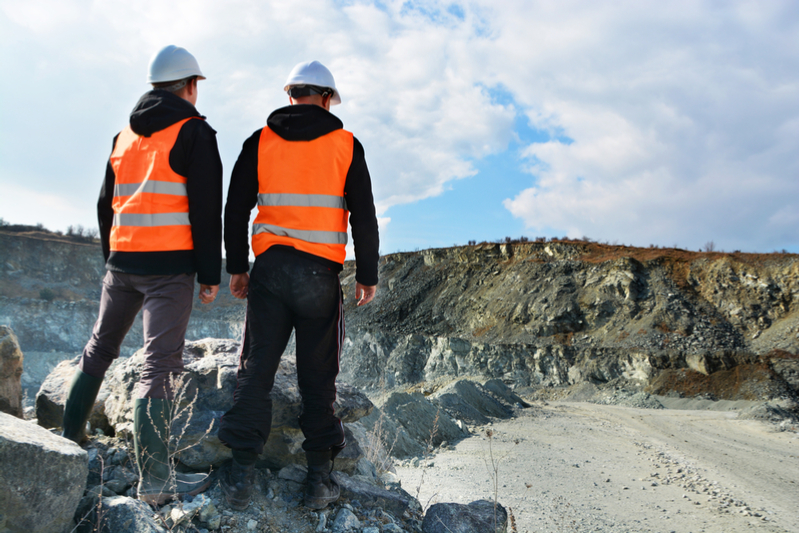Top tips for preventing exposure to silica dust in the workplace

Silica is a natural substance but can have a detrimental effect on health if it’s breathed in.
Silica is found in rocks, sand, clay as well as certain plastics and industries which work with these materials can be at risk of silica exposure. Due to its impact, it’s vital for employers to protect their workers’ health and wellbeing by preventing exposure to silica dust.
Because of the type of materials silica is naturally found in, construction and industrial workers are at an increased risk of coming into contact with silica dust which is generated in day-to-day processes. When these materials are cut, sanded, carved, drilled, grinded or polished, they produce an extremely fine dust called respirable crystalline silica (RCS). It is so fine, you cannot see it in normal lighting. Heavy and prolonged exposure to silica can cause silicosis, chronic obstructive pulmonary disease (COPD) and even lung cancer if it’s breathed deeply into the lungs.
The symptoms of silicosis include a persistent cough, shortness of breath and tiredness and is usually developed after being exposed to silica dust for many years. However, silicosis may not develop for some time after exposure so a sufferer could have stopped working with silica dust for a number of years before noticing symptoms. If left untreated, it can cause serious damage to lungs, and increase the likelihood of also developing COPD and lung cancer.
The amount of silica exposure needed to cause damage to the lungs is small and therefore must be kept minimal. Shockingly, the Health and Safety Executive (HSE) reports more than 500 construction workers are believed to die from silica dust exposure every year. Exposure can occur when carrying out operations such as sawing and grinding as well as when opening bags of material, moving and mixing raw materials and in associated clean-up operations. Staff working nearby can also be exposed if the right control measures are not in place.
To reduce workers’ exposure to silica dust, the HSE advises that employers must comply with The Control of Substances Hazardous to Health Regulations 2002 (COSHH). This involves completing a risk assessment to identify if materials with a lower level of RCS can be used to reduce the risk of exposure. For example, sandstone has the highest level of silica – in excess of 70% – while mortar and concrete can have between 25-70%. By comparison, slate has 20%-40% silica, ironstone has up to 15% while basalt and marble have up to 5%. Limestone has as little as 2% silica.
No matter which material your staff are working with, the necessary precautions must be taken to prevent exposure to silica dust as much as possible. Here are some of phs Besafe’s top tips for minimising the risk of silica dust in the workplace.

Provide suitable protective workwear
If employees are going to be working with materials containing silica dust, one of the best ways to minimise exposure is by providing them with the correct personal protective equipment (PPE), such as respirators to cover the nose and mouth. Whether you provide disposable filtering respirators (which provide a minimal level of protection) or half or full-face respirators will depend on the type of environment staff are working in. However, it’s vital to ensure disposable respirators are changed regularly, and that half and full-face respirators are cleaned after use, as well as being tight-fitting (this requires wearers to be clean shaven).
When working in the types of environments where materials containing silica dust are found (such as mines, quarries, railways, and general construction sites), workers also need to wear suitable high-visibility or flame-resistant workwear. As with respirators, the type of protective workwear you’ll need to provide will depend on the environment they’re working in.
Staff must be trained to use, check and clean the PPE and any defects or ill-fitting items to be reported and rectified quickly.
Correctly clean equipment and protective workwear
When working in environments with high levels of silica dust, you must also be aware of the risk of contamination, and this can occur when laundering protective workwear. If workwear worn in these environments is washed with other garments, these could be contaminated by silica dust, which can be so fine that it’s impossible to determine if it’s been completely removed from the workwear during the laundering process. Therefore, it’s essential that these garments are washed separately.
One of the easiest ways to eliminate extended exposure to silica dust is by taking your laundry off-site and using a specialist company, such as phs Besafe. As part of our industrial laundering service, we launder workwear in a soluble bag, which minimises contamination. All you need to do is place each garment in a bag (with a blue repair tag attached to the outside), place the bags in a dirty collector bin, and we’ll collect this from your site.
In addition to this, any equipment used when working with silica dust must be cleaned after each use, as well as stored in a clean, dust-free place when not in use.
Practice good personal hygiene at work
Although employers have a legal obligation to protect the health, safety, and well-being of their staff, (which means they must comply with COSHH when employees are working with materials that create silica dust) individual employees are also responsible for following their employer’s health and safety advice and instructions when working in such environments.
As NIOSH (The National Institute for Occupational Safety and Health) recommends, this involves each worker practicing good personal hygiene in the workplace. Some of the best ways this can be achieved is by changing into their protective workwear when they arrive on-site, not eating, drinking or smoking in areas where silica dust is present, and washing their hands before eating, drinking, or smoking after working in these areas (even if they have left the site). additionally, workers can practice good hygiene to prevent their exposure to silica dust by showering (if possible) and changing out of their workwear before leaving the worksite.
Mitigate the risks
Education and awareness of the risk of silica exposure is necessary amongst every staff member so that the risks can be mitigated. Cutting and drilling materials containing silica should be avoided where possible. If it is required, manual tools can create less dust than power tools. Extraction tools, HEPA-filtered vacuuming, ventilation and integrated water delivery systems can help control the dust produced with regular cleaning and dust management essential. It is best practice to limit worker access to high exposure areas, measure exposures, operate an exposure control plan and monitor the health of staff.
For more information on phs Besafe’s protective workwear ranges, and specialist industrial laundry service, contact us today.